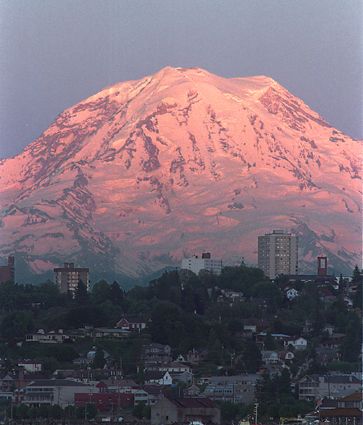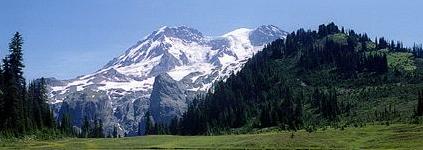Mount Rainier has stood as a towering witness to the creation and evolution of the Puget Sound basin. When sheets of ice crept across the landscape, retreated, then returned, the mountain looked on. Mammoths, giant sloths an saber-toothed cats prowled in its shadow.
Rainier's age is hard for the human mind to conceive, but geologically speaking, it's a youngster.
The Northwest coast has been roiled by volcanism for more than a million years, beginning when the region was a warm swamp fringed by palm trees and tropical ferns. Volcanoes rose up, then become islands as the sea crept in.
About 25 million years ago, floods of lava poured across the Northwest, piling more than 600 feet thick in places.
The grainy granodiorite rocks that Rainier sits on today fueled volcanoes 12 million years ago.
Before Rainier blossomed, there was another volcano on the same spot. Million-year-old remnants of this ancenstor remain on Rainier's margins, but the rest has been worn away.

The mountain we know was born 500,000 to 600,000 years ago. Lava poured from the ground and spread up to 15 miles away. Successive eruptions piled layer upon layer.
About the same time, other Cascade volcanoes also appeared, including Mount Adams, And Mount Shasta. (At 45,000 years old, Mount St. Helens is a baby.) The basic force that generated the volcanoes is the crashing and gnashing of the vast geologic plates that grind the planet.
Mount Rainier's active cylces run about 150 to 200 years apart and the last activity was about 150 years ago when the mountain heated up, causing the glaciers to melt, sending mud and water rushing into the Puget Sound.
Beneath the Pacific Ocean, liquid rock from the hot asthenosphere is pushing up along the bottom of deep rifts. This infusion of fresh rock forces the oceanic plate to spread. When it collides with the plates that make up the continents, something has to give.

In some places, colliding plates crumple against each other and throw up mountain ranges. That how the olympics and much of the Cascades formed.
The Cascade volcanoes were spawned by a different mechanism.
Off the coast of Washington, Oregon, and British Columbia, a section of dense ocean floor called the Juan de Fuca Plate is being forced beneath the lighter North American plate.

It sinks into the Earth at a rate of 1.5 inches a year, about a third as fast as hair grows. Squeezed and heated as it descends, the rock dissolves into magma. At weak places in the Earth's crust, that molten seeps or explodes to the surface, and a volcano sprouts.
This fiery subduction is occuring all around the rim of the Pacific, from Indonesia to Japan and New Zealand. More than 60 percent of the world's volcanoes are in this Ring of Fire.